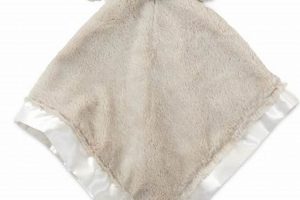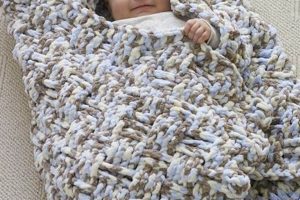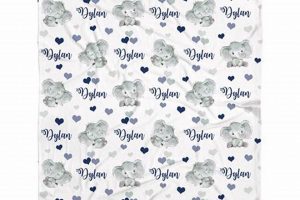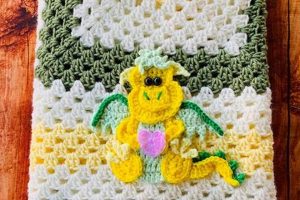The selection of textiles for infants’ coverings necessitates careful consideration. These materials serve to provide warmth and comfort while prioritizing the safety and well-being of the child. Examples include cotton flannel, known for its softness and breathability; muslin, valued for its lightweight and open weave; and fleece, appreciated for its warmth and durability. The chosen fabric significantly impacts the infant’s tactile experience and thermal regulation.
The appropriate choice is crucial for several reasons. Breathability helps minimize the risk of overheating, a significant concern for newborns. Softness prevents skin irritation and promotes comfort, contributing to better sleep. Durability ensures the item can withstand frequent washing and extended use. Historically, natural fibers like cotton and wool were preferred, but advancements in textile technology have introduced synthetic options with enhanced properties such as hypoallergenic qualities and ease of care.
Subsequent discussion will address specific fiber types, their respective advantages and disadvantages, and factors to consider when selecting the most suitable option for a particular infant’s needs. Examination of weave patterns, weight, and care instructions will further assist in making informed decisions regarding purchase and maintenance.
Material Selection Guidance
The following guidance aims to provide information concerning the proper selection and utilization of fabrics designed for infant coverings, emphasizing safety, comfort, and practicality.
Tip 1: Prioritize Natural Fibers: Cotton and bamboo offer superior breathability and reduced risk of allergic reactions compared to synthetic alternatives. Opt for organic cotton whenever possible to minimize exposure to harmful chemicals.
Tip 2: Evaluate Weave Density: Tightly woven fabrics, while potentially warmer, may restrict airflow. Looser weaves, such as muslin, promote ventilation and reduce the risk of overheating.
Tip 3: Consider Weight and Thickness: Lightweight options are preferable for warmer climates or swaddling, while thicker materials are suitable for colder environments. Avoid excessively bulky fabrics that could pose a suffocation hazard.
Tip 4: Assess Allergen Potential: Some infants exhibit sensitivities to wool or synthetic fibers. Conduct a skin patch test with a small sample of the material before widespread use.
Tip 5: Review Care Instructions: Select fabrics that are machine washable and dryer-safe for ease of maintenance. Avoid using harsh detergents or fabric softeners that could irritate sensitive skin.
Tip 6: Inspect for Loose Threads or Embellishments: Regularly check for any loose threads, buttons, or other embellishments that could detach and present a choking hazard. Remove any such hazards immediately.
Tip 7: Monitor Infant’s Temperature: Regardless of the chosen fabric, carefully monitor the infant’s temperature to prevent overheating or excessive cooling. Adjust the layers of covering as needed.
Selecting an appropriate fabric involves a balance between comfort, safety, and practicality. Thoughtful consideration of these guidelines will assist in making informed decisions regarding infant well-being.
Further discussion will delve into specific techniques for safe swaddling and optimal thermal regulation in infants.
1. Softness
Softness, as a tactile property, is a primary determinant in the suitability of fabrics intended for infant use. The physiological sensitivity of neonatal skin necessitates careful consideration of textile texture to mitigate potential irritation or discomfort.
- Fiber Composition and Softness Perception
The inherent characteristics of the fiber directly influence perceived softness. Natural fibers, such as long-staple cotton varieties and bamboo, are generally considered softer than coarser synthetic options. The fineness of the fiber, measured in micrometers, correlates with a smoother texture and reduced friction against the skin. Fiber processing techniques, such as mercerization for cotton, can further enhance softness.
- Weave Structure and Surface Texture
The construction of the fabric significantly impacts surface texture. Knitted fabrics, due to their looped structure, tend to be more pliable and softer than woven fabrics. Looser weaves create a more open and less abrasive surface. Napping, a process used to raise the surface fibers, as seen in flannel, increases softness but can also affect durability and propensity for pilling.
- Chemical Treatments and Softness Enhancement
Chemical finishes are frequently applied to textiles to improve softness. Silicone softeners and enzymatic treatments are common examples. However, potential residual chemicals must be evaluated for safety, particularly in products intended for infant contact. Stringent testing and certification, such as Oeko-Tex Standard 100, are crucial to ensure the absence of harmful substances.
- Subjective Perception and Sensory Evaluation
While objective measurements of fiber fineness and surface friction provide quantifiable data, the ultimate determination of softness relies on subjective human perception. Sensory evaluation, involving tactile assessment by trained panels, can provide valuable insights into consumer preferences and perceived comfort levels. However, individual sensitivities and preferences may vary significantly.
The integration of fiber selection, weave construction, and finishing processes significantly impacts the overall softness profile of fabrics for infant use. Balancing the objective attributes of the material with the subjective experience of softness is essential in selecting the most appropriate option for the infant’s well-being and comfort. Consideration of these factors contributes to the creation of a safe and nurturing environment.
2. Breathability
Breathability, referring to the capacity of a material to permit the passage of air and moisture vapor, is a critical attribute in fabrics intended for infants. Insufficient breathability can lead to overheating, discomfort, and potentially increase the risk of Sudden Infant Death Syndrome (SIDS). Therefore, the selection of fabric with adequate breathability is paramount in the creation of infant coverings.
- Fiber Type and Air Permeability
Different fiber types exhibit varying degrees of air permeability. Natural fibers, such as cotton, linen, and bamboo, possess inherent porosity that allows for greater airflow compared to many synthetic fibers. The structure of the fiber itself influences its ability to facilitate air movement. For example, cotton fibers, with their convoluted shape, create spaces between yarns, promoting ventilation.
- Weave Construction and Airflow
The weave pattern of the fabric significantly impacts its breathability. Loose weaves, such as muslin and gauze, create larger interstices between yarns, allowing for increased airflow. Tightly woven fabrics, while potentially offering greater warmth or durability, restrict air passage. The choice of weave should align with the intended use and environmental conditions to ensure adequate ventilation.
- Moisture-Wicking Properties
Breathability is intrinsically linked to the fabric’s ability to wick moisture away from the infant’s skin. Materials with good moisture-wicking properties, such as merino wool and certain synthetic microfibers, facilitate the evaporation of sweat, preventing the build-up of moisture that can lead to discomfort and potential skin irritation. Efficient moisture management contributes to overall thermal regulation.
- Environmental Considerations and Air Exchange
The surrounding environment plays a crucial role in determining the effectiveness of a fabric’s breathability. In humid conditions, even highly breathable materials may become less effective due to reduced air exchange. Parents and caregivers must consider the ambient temperature and humidity levels when selecting infant coverings and adjust the layering accordingly to prevent overheating.
The interplay between fiber type, weave construction, moisture-wicking capabilities, and environmental factors collectively determines the breathability of materials utilized in items made for infants. Selection should prioritize fabrics that effectively promote air circulation and moisture evaporation to maintain a safe and comfortable thermal environment. A comprehensive understanding of these principles is essential for informed decision-making in the creation of infant care items.
3. Durability
Durability, in the context of infant coverings, refers to the material’s capacity to withstand repeated use, laundering, and the stresses inherent in handling by both infants and caregivers. The connection between material choice and longevity is direct; certain fibers and weaves inherently exhibit greater resistance to wear and tear. The impact of durability extends beyond mere economic considerations. A longer lifespan reduces the frequency of replacement, minimizing resource consumption and environmental impact. Furthermore, a durable item maintains its integrity over time, lessening the likelihood of fabric degradation that could present safety hazards such as loose threads or compromised structural integrity. For example, a tightly woven cotton flannel, though initially soft, may exhibit reduced durability compared to a similarly treated cotton twill, particularly after numerous wash cycles. The former might pill and thin, while the latter maintains its structure and strength.
The selection of more robust materials often involves trade-offs with other desirable characteristics. A high thread-count cotton, while durable, might possess reduced breathability compared to a loosely woven muslin. Similarly, synthetic blends, incorporating polyester or nylon, can enhance durability but may compromise the fabric’s softness or hypoallergenic properties. Therefore, a balanced approach is required, considering the relative importance of each characteristic in the specific application. Practical application involves carefully evaluating the intended use of the item. A frequently used swaddling fabric necessitates a more durable construction than a decorative receiving blanket. Labeling requirements, including wash instructions, are critical to maintaining the material’s integrity and maximizing its lifespan. Adherence to these guidelines can significantly extend the usable life of the product.
In summary, durability is a crucial component influencing the overall value and safety of fabrics used in manufacturing goods for infants. The choice of material, weave, and care practices significantly impacts the items ability to withstand repeated use and maintain its structural integrity. Balancing durability with other desirable characteristics, such as softness and breathability, requires careful consideration of the intended application and adherence to proper care protocols. Addressing the challenges of selecting for durability necessitates a thorough understanding of textile properties and responsible consumer practices.
4. Hypoallergenic
The term “hypoallergenic,” when applied to materials used in infants’ coverings, denotes a reduced propensity to provoke allergic reactions. This characteristic is of paramount importance given the heightened sensitivity of neonatal skin and the potential for developing allergies early in life. Selection criteria should prioritize materials known to minimize allergenic response.
- Fiber Selection and Allergenicity
Certain natural and synthetic fibers are inherently less likely to trigger allergic reactions. Examples include organic cotton, bamboo, and specific types of microfibers. Organic cotton minimizes exposure to pesticides and chemical treatments that can irritate sensitive skin. Bamboo possesses natural antimicrobial properties, potentially reducing the growth of allergens. Conversely, wool, while possessing desirable thermal properties, can contain lanolin, a known allergen for some individuals. Careful consideration of fiber composition is essential in mitigating allergic risk.
- Dye Selection and Chemical Sensitivity
The dyes and chemical finishes applied to fabrics can also contribute to allergic reactions. Azo dyes and formaldehyde-releasing resins are known irritants and should be avoided. Opting for low-impact dyes and water-based prints can significantly reduce the risk of chemical sensitivity. Certification standards, such as Oeko-Tex Standard 100, verify that textiles have been tested for harmful substances, including potential allergens. The selection of materials free from such chemicals is critical for infant well-being.
- Weave Structure and Allergen Accumulation
The weave structure of a fabric can influence its tendency to accumulate allergens, such as dust mites and pet dander. Tightly woven fabrics provide a denser barrier, reducing allergen penetration. Regular laundering at appropriate temperatures further minimizes allergen accumulation. Selecting materials that are easily washable and resistant to allergen retention contributes to a hypoallergenic environment for the infant.
- Manufacturing Processes and Residue Removal
Manufacturing processes can leave behind residues that may trigger allergic reactions. Thorough washing prior to first use is essential to remove any residual chemicals or manufacturing byproducts. Selecting materials from manufacturers with stringent quality control measures and transparent production practices further minimizes the risk of exposure to allergenic substances. Verification of manufacturing processes that prioritize residue removal provides an added layer of protection for the infant.
The selection of “baby blanket material” that is truly hypoallergenic requires a comprehensive assessment of fiber composition, dye selection, weave structure, and manufacturing processes. By prioritizing materials known to minimize allergenicity and adhering to best practices in care and maintenance, parents and caregivers can create a safer and more comfortable environment for infants.
5. Washability
Washability, denoting a material’s capacity to withstand repeated cleaning without significant degradation, is a paramount consideration in the selection of textiles used for infant coverings. The frequency with which these items require laundering necessitates a careful evaluation of their ability to maintain structural integrity, colorfastness, and softness throughout numerous wash cycles.
- Fiber Composition and Wash Resistance
The intrinsic properties of constituent fibers significantly impact washability. Natural fibers such as cotton and linen, while generally amenable to machine washing, may exhibit shrinkage or fading with repeated exposure to high temperatures. Synthetic fibers, including polyester and acrylic, offer superior resistance to shrinkage and color loss but may be more prone to static cling or pilling. Blends of natural and synthetic fibers often represent a compromise, balancing washability with other desirable characteristics such as softness and breathability. For example, a cotton-polyester blend offers greater resistance to shrinkage compared to 100% cotton, while retaining a reasonable degree of softness.
- Weave Structure and Dimensional Stability
The manner in which fibers are interlaced significantly influences a fabric’s dimensional stability during washing. Tightly woven fabrics generally exhibit less distortion than loosely knit materials. Bias-cut items are particularly susceptible to stretching or warping during laundering. Pre-shrinking processes, applied during manufacturing, can mitigate dimensional changes but do not entirely eliminate the risk of distortion. In practical terms, a tightly woven cotton flannel is likely to maintain its shape better than a loosely knitted chenille fabric after repeated washing.
- Dye Chemistry and Colorfastness
The chemical composition of dyes and the dyeing process itself determine a fabric’s resistance to color loss during washing. Reactive dyes, which form a chemical bond with the fiber, generally exhibit superior colorfastness compared to pigment dyes, which are mechanically adhered to the surface. Washing instructions, including recommended water temperature and detergent type, directly impact color retention. Dark-colored or heavily dyed fabrics often require special care to prevent bleeding or fading. For instance, washing a brightly colored cotton blanket in cold water with a color-safe detergent can minimize fading and preserve its original appearance.
- Care Label Instructions and Maintenance
Care label instructions, provided by the manufacturer, represent a critical guide for maintaining the washability of textiles. Adhering to these instructions, including recommended water temperature, drying method, and ironing settings, significantly extends the lifespan of the item. Ignoring these guidelines can result in irreversible damage, including shrinkage, distortion, color loss, or fiber degradation. For example, failing to heed the instruction to tumble dry on low heat can cause excessive shrinkage in a wool blanket, rendering it unusable.
The interplay between fiber composition, weave structure, dye chemistry, and adherence to care label instructions collectively dictates the washability of “baby blanket material”. Careful consideration of these factors enables informed selection of materials that withstand frequent laundering, maintaining hygiene and extending the useful life of the covering while ensuring the continued comfort and safety of the infant.
6. Weight
Weight, measured in grams per square meter (GSM) or ounces per square yard, is a significant property of textiles used in infant coverings, influencing warmth, breathability, and overall comfort. The selection of an appropriate weight is contingent upon the intended use and environmental conditions.
- Thermal Regulation and Fabric Weight
Heavier materials provide greater insulation, trapping more air and offering increased warmth in colder environments. Conversely, lighter materials facilitate air circulation, preventing overheating in warmer climates. An excessively heavy fabric can pose a risk of overheating, particularly in newborns. Conversely, a too-light covering may fail to provide adequate warmth in cold conditions. Practical application involves selecting a higher GSM fleece for winter and a lower GSM muslin for summer swaddling.
- Drape and Conformity to Body
Fabric weight influences drape, or how the material falls and conforms to the body. Lighter-weight textiles tend to drape more fluidly, conforming closely to the infant’s form. This can be advantageous for swaddling, providing a secure and snug fit. Heavier fabrics have a stiffer drape and may not conform as readily, potentially creating gaps and reducing warmth. A lightweight cotton voile drapes more closely than a heavier denim fabric.
- Safety Considerations Related to Weight
Excessively heavy coverings can pose a safety hazard, particularly for infants with limited mobility. A very heavy item could restrict movement or impede breathing if it shifts over the infant’s face. Lighter options minimize this risk. Safe practice dictates avoiding heavy quilts or weighted options in infant sleep environments. The weight of each blanket should be proportional to the baby size. Over weight fabrics should be avoided for new born.
- Durability and Material Weight
Generally, heavier fabrics tend to be more durable than lighter counterparts, as they contain more material per unit area. This increased density translates to greater resistance to wear and tear. However, the specific fiber content and weave construction also play a significant role in determining overall durability. A heavy-weight linen may be more durable than a lightweight silk, despite silk having a naturally higher tensile strength.
Weight is an inherent property of “baby blanket material” which influences the performance and safety. A balance between thermal regulation, drape, safety, and durability guides selection based on specific needs and environmental factors. A deeper analysis of fiber type, weave, and construction should happen with weight selection.
7. Fiber Type
Fiber type constitutes a foundational consideration in the selection of materials designed for infant coverings. The intrinsic properties of various fibers significantly influence the blanket’s safety, comfort, durability, and overall suitability for use with neonates and young children. The following points elaborate on key facets of fiber type and their direct relevance to textiles used for infants.
- Natural Fibers: Cotton
Cotton, particularly organic varieties, remains a prevalent choice due to its softness, breathability, and absorbency. Organic cotton minimizes exposure to pesticides and harsh chemicals, reducing the risk of skin irritation. However, cotton can be prone to shrinkage and may not be as durable as some synthetic alternatives. The fiber’s inherent properties make it suitable for warmer climates or for infants with sensitive skin, provided that measures are taken to mitigate potential shrinkage during laundering.
- Natural Fibers: Bamboo
Bamboo-derived fabrics exhibit exceptional softness and moisture-wicking properties, making them a viable option for infant coverings. Bamboo is a rapidly renewable resource, offering environmental advantages over conventional cotton production. However, the process of converting bamboo into fabric often involves chemical treatments, and the resulting material may not always retain its inherent antimicrobial properties. Transparency regarding the manufacturing process is crucial when selecting bamboo fabrics for infant use.
- Synthetic Fibers: Fleece (Polyester)
Polyester fleece offers warmth, durability, and resistance to pilling, making it a practical choice for cooler climates. Fleece is relatively inexpensive and easy to care for, but it is less breathable than natural fibers and can contribute to static cling. Moreover, concerns exist regarding microplastic shedding during washing, which can pose environmental and potential health risks. The selection of fleece should be balanced with consideration of its environmental impact and the infant’s potential exposure to microplastics.
- Synthetic Fibers: Microfiber
Microfiber fabrics, composed of ultra-fine synthetic fibers, exhibit exceptional softness and moisture-wicking capabilities. Certain microfibers are specifically engineered to be hypoallergenic, making them suitable for infants with sensitivities. However, like fleece, microfibers can be prone to static cling and may contribute to microplastic shedding. Careful consideration of the fabric’s construction and manufacturing process is essential to minimize these potential drawbacks.
The choice of fiber type is not a singular decision but rather a multifaceted consideration that involves balancing the desired properties of the infant covering with potential drawbacks related to safety, environmental impact, and manufacturing practices. Careful evaluation of the fiber’s origin, processing methods, and performance characteristics is essential in selecting the most appropriate material for a particular infant’s needs.
Frequently Asked Questions About Fabrics Intended for Infant Coverings
This section addresses common inquiries concerning the selection and utilization of “baby blanket material”, offering clarification and guidance based on established textile properties and safety considerations.
Question 1: What constitutes a truly hypoallergenic fabric appropriate for newborns?
A truly hypoallergenic fabric minimizes the potential for allergic reactions. Selection should prioritize certified organic cotton, bamboo rayon processed without harsh chemicals, or specific microfibers engineered for sensitive skin. Independent certification, such as Oeko-Tex Standard 100, provides assurance regarding the absence of known allergens and harmful substances.
Question 2: How does weave density impact the safety and comfort of infants?
Tightly woven fabrics, while potentially more durable, can restrict airflow and increase the risk of overheating. Looser weaves, such as muslin or gauze, promote ventilation, mitigating this risk. However, excessively loose weaves may pose a snagging hazard. The optimal weave density balances breathability and structural integrity.
Question 3: What are the key considerations in balancing warmth and breathability?
Achieving a balance between warmth and breathability is critical for infant thermal regulation. Lighter-weight, breathable fabrics like muslin are suitable for warmer environments, while heavier-weight, insulated materials like fleece are appropriate for colder conditions. Layering fabrics allows for adjustments based on ambient temperature and the infant’s individual needs.
Question 4: What precautions should be taken when selecting synthetic fiber options?
Synthetic fibers, such as polyester fleece or microfiber, offer durability and ease of care, but potential concerns exist regarding breathability, static cling, and microplastic shedding. Selecting high-quality microfibers and using a garment bag during laundering can minimize microplastic release. Furthermore, ensuring adequate ventilation remains crucial to prevent overheating.
Question 5: How does wash frequency affect the integrity of infant coverings?
Frequent washing, essential for maintaining hygiene, can degrade fabric integrity over time. Selecting durable materials and following care label instructions is crucial to prolonging the lifespan of infant coverings. Using gentle detergents and avoiding harsh chemicals can further minimize wear and tear.
Question 6: What role does fabric weight play in infant safety?
Fabric weight influences thermal regulation and potential safety risks. Excessively heavy fabrics can restrict movement or impede breathing. Lighter-weight options are generally preferred, minimizing the risk of suffocation or overheating. Careful consideration of fabric weight is particularly important in sleep environments.
The preceding answers emphasize the multi-faceted nature of selecting fabrics appropriate for infant coverings. A comprehensive understanding of fiber properties, weave structures, and safety considerations informs responsible purchasing decisions.
The following section will provide concluding recommendations regarding the optimal use of “baby blanket material” in diverse scenarios.
Baby Blanket Material
The preceding analysis has detailed the multifaceted considerations involved in the selection of textiles for infant coverings. Key points include the criticality of fiber type, weave structure, weight, and washability in ensuring safety, comfort, and durability. Hypoallergenic properties, coupled with the minimization of chemical exposure, remain paramount. Decisions require balancing various factors to mitigate potential risks such as overheating, allergic reactions, and physical hazards.
Given the critical role of textiles in infant well-being, manufacturers, caregivers, and regulators must uphold stringent standards in material selection and usage. Continued research and innovation are essential to developing even safer and more effective options for infant coverings. Responsible choices contribute significantly to creating a secure and nurturing environment for the developing child.







